How to Do an AI Competitor Analysis? Example + 8 Actionable Steps [2025]
Table of contents
Competitor analysis is like trying your friends’ pizza slices before ordering your own — so you know who’s got the best toppings. Sure, you never know if the final result will be exactly what you hoped for, but at least you won’t end up with a slice no one wants. Let me guide you through the steps of a competitor analysis that will help you create the perfect strategy for your business. Slice by slice.
Competitor analysis (also known as competitive analysis) is a set of tactics for identifying, analyzing, and understanding your industry’s competitors.
This process helps you uncover their strengths, weaknesses, business and marketing strategies, and market positioning to refine your own strategy, identify opportunities, and gain a competitive edge in the market.
What is competitor analysis? Definition
Let’s start with the basics. What is competitive analysis, and why should you care?
In short, a competitor analysis is a strategic process of identifying and evaluating market rivals.
It aims to understand competitors’ strengths and weaknesses, as well as opportunities and threats to gain a competitive edge.
So, by examining your competitors, you gain insights into the external factors that directly affect your business. And these insights help you adjust your internal strategies to stay ahead in the market.
Fine, and what insights precisely can you get from the competitive analysis? What could you improve thanks to an effective competitor analysis?
Honestly, a lot!
Among the most significant ones, there are:
- Competitive landscape and positioning: Understand where your business stands compared to your competitors.
- Product or service offerings: Evaluate the range and quality of products/services offered by competitors.
- Pricing strategies: Understand competitors’ pricing models and strategies.
- Marketing strategy: Analyze how competitors market their products and which marketing channels they use.
- Customer engagement: See how they engage with customers and the effectiveness of their communication strategies.
- User experience: Understand the customer experience they provide, including any pain points.
- Customer feedback: Analyze customer reviews and feedback to gain insights into their strengths and areas for improvement.
Start your competitor analysis now!
How to do a competitive analysis? 8 steps
As you might have guessed, competitor analysis is a huge task, both in terms of the amount of information you will have to process and the resources it requires.
To have a comprehensive view of your competition’s activities and strategies, you should analyze many different aspects of the company’s presence.
Thorough target market research is the foundation of competitor data.
Before proceeding with the promised eight steps, I want you to remember one thing – a competitive analysis is not about copying competitors’ solutions.
It’s more about inspiring yourself, positioning your company in the right market, knowing what market trends are worth following, and improving your processes, products & services.
In other words, competitive analysis is a process of:
- Defining your strengths and weaknesses in relation to your market rivals;
- Discovering your strengths and weaknesses;
- Adjusting your strategy accordingly to increase your market share.
All clear? Great!
So, let me guide you through our competitive analysis framework.
01 Find your competitors
I think it’s a no-brainer: if you want to conduct a thorough competitive analysis, the first step is to identify competitors. That makes sense, right?
All right, and how do you discover your key competitors in practice? Let me show you four simple techniques.
Google search
If you don’t know how to start, just google it (or bing it or duckduckgo it)!
The world’s most popular search engine works really well for finding competitors.
Start by typing the most obvious keywords that are relevant to your business, product, or service. You can use phrases like:
- “[brand name] competitors” or “[brand name] alternatives”, i.e., Nike competitors
- “top [industry] brands”, i.e., top smartwatch brands
- “best [product or service] for [your need]”, i.e., best camera for vlogging
Look at the top results — both the organic and paid ads — to identify who is ranking for those terms. These are likely to be some of your main competitors.
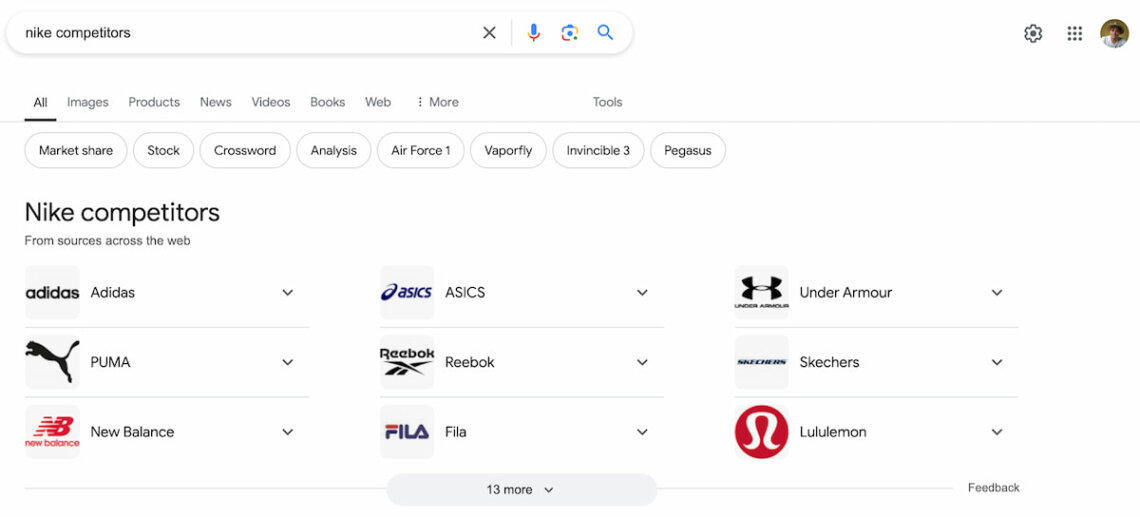
Remember that Google will only spit out uncategorized results.
Your job will be to divide the businesses into categories and check all other available information, such as when they were established, the number of clients, industry share of voice, etc.
GOOD TIP
Try to imagine yourself as a potential customer looking for your products or services and search for terms related to your business niche. Do it in incognito mode so the search engine won’t consider your previous searches.
Start your competitor analysis now!
Google ads
While we’re at search engines – take a look at paid ads.
Some of your direct and indirect competitors might not be interested in SEO positioning (which takes some time and resources to develop). Instead, they will pay for promotion.
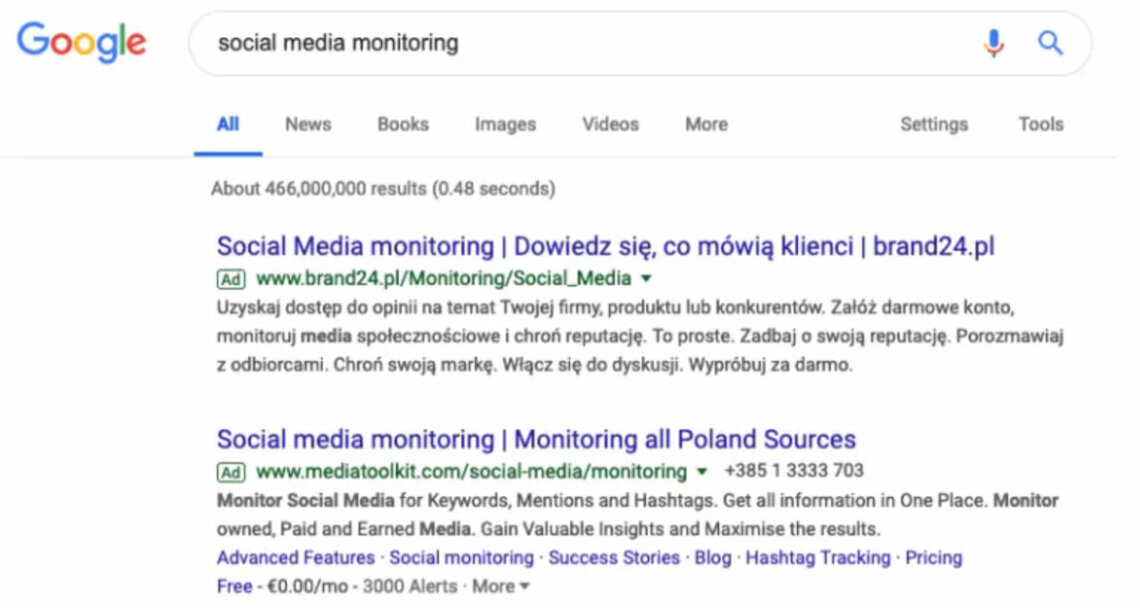
Follow the same process as in the previous point, just take a look at ads, not organic results.
Competitor analysis tools
Another great method for discovering your industry rivals is using competitor monitoring tools.
They allow you to find (and later analyze) direct competitors quickly.
For example, Brand24 – a media monitoring tool that allows you to track and analyze public mentions of your brand – offers an AI Brand Assistant feature that works great for that purpose.
You can simply type a relevant question (i.e., “Who are the main competitors for my brand?”) and check the results you can use for further analysis.
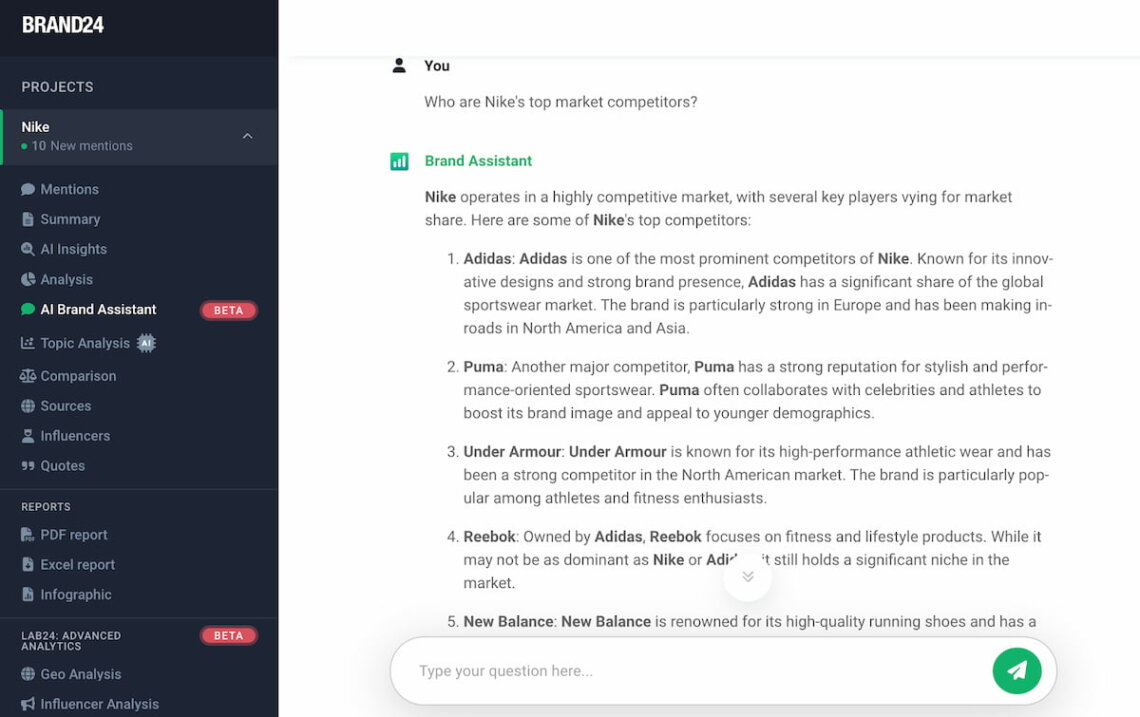
Read more: Check other Brand24’s AI Solutions
Customer research
Your customers are a goldmine of knowledge.
Before they came to you, most of them had done a ton of research to choose the best solution for their problem. You should tap into that knowledge!
Ask what other options they considered and which feature made them sway in your direction.
Moreover, new companies will likely try to tempt your customers to switch to their products. Keeping your finger on the pulse will help you detect early signs of a new rival on the market.
You can ask your new clients to answer a few questions, fill out a survey, or schedule a short phone call. Try to build an email list so you can easily reach your clients.
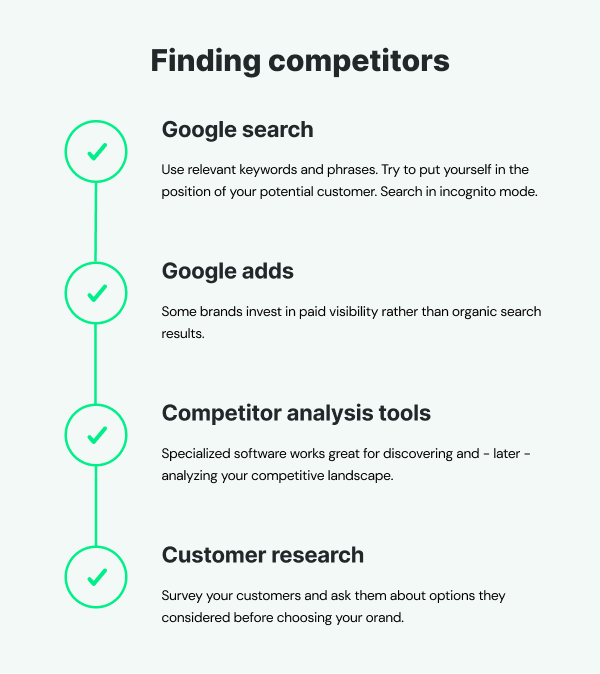
Once you discover your competitors, I suggest you divide them into three groups:
- Primary competitors – businesses that target the same audience or have similar products.
- Secondary competitors – businesses that sell products in the same category. For example, a secondary competitor to a brewery is a vineyard.
- Tertiary competitors – businesses that are not your direct competitors but might become one in the future (if you expand your product line or service).
Direct and indirect competitors
Direct competitors offer the same or very similar products/services to the same target audience as you. In other words, you are competing directly for the same customers.
Indirect competitors provide different products/services that meet the same customer need or solve the same problem as you, but in a different way.
So, while your direct competitors are in the same industry, your indirect competitors might be in related industries.
The difference between direct and indirect competitors is important for correctly assessing your strengths, weaknesses, opportunities, and threats.
Discover your direct and indirect competitors easily!
02 Check publicly available data
Once you identify the most relevant competitors, it’s time to dive deeper into the available data. This step of competitor research can unveil many incredibly valuable details.
You can use sources (and discover data) like:
- Competitors’ websites to get familiar with their CEO, management structure, history, business values, product offerings, pricing, content strategy, user experience, etc.;
- Social media profiles to discover their content strategy, engagement, posting frequency, and audience demographics;
- Business databases (i.e., Bloomberg Terminal) to get insights into their financial health and strategic priorities;
- Press releases and news articles to stay updated with their latest developments, partnerships, product launches, etc.;
- Market research & consulting reports (i.e., Gartner) to check competitors’ market positioning
- Review platforms to analyze customer satisfaction and service experiences
- Media monitoring tools to understand competitors’ communication & marketing strategies, top sources of mentions, reputation, sentiment, industry share of voice, Advertisement Value Equivalency, etc.
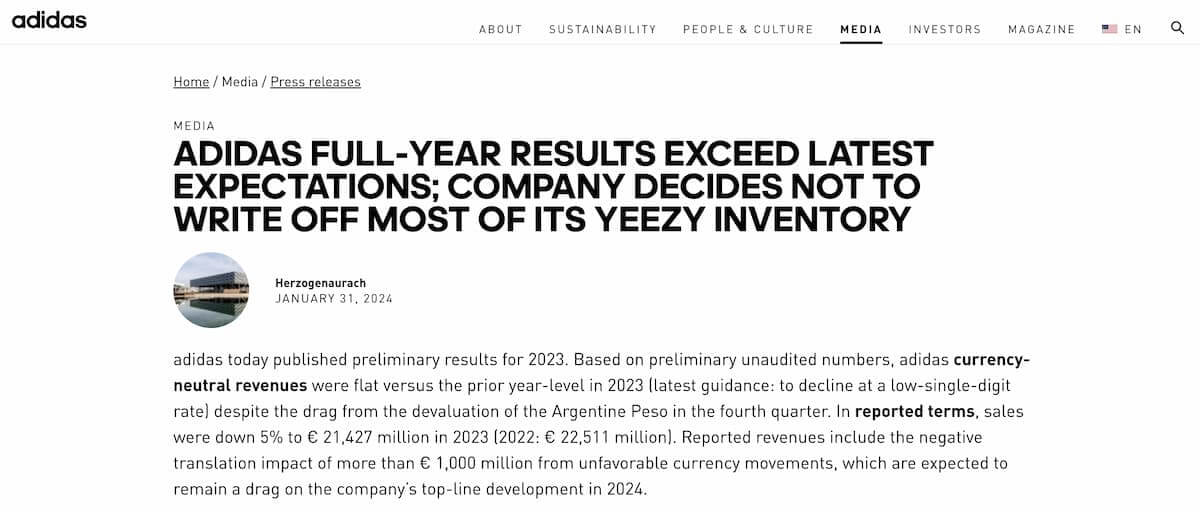
03 Examine the products/services
Now it’s time to take a closer look at the products or services your rivals offer. Focus on the following:
- Technology – what technology was used to build the product?
- Lead magnets and perks – do they give anything for free, for example, ebooks or webinars? Do they offer discounts?
- Core selling point – who exactly are they targeting?
A thorough analysis of the product will help you identify gaps in your competitors’ offerings.
Once you identify the market gap, you can try to fill it with your products. Are there any opportunities for your products on the market?
Look for any affiliate programs they might run. Affiliate programs help spread brand awareness and boost sales.
Another aspect of competitive analysis, especially for tech companies, is to assess what technology they use. You can check it in two ways.
First, there are websites, such as BuiltWith or Wappalyzer, that help you discover the technology behind the product.
Secondly, take a look at job listings. Companies will list the stack needed for new hires, including programming language, email marketing services, analytics systems, and much more.
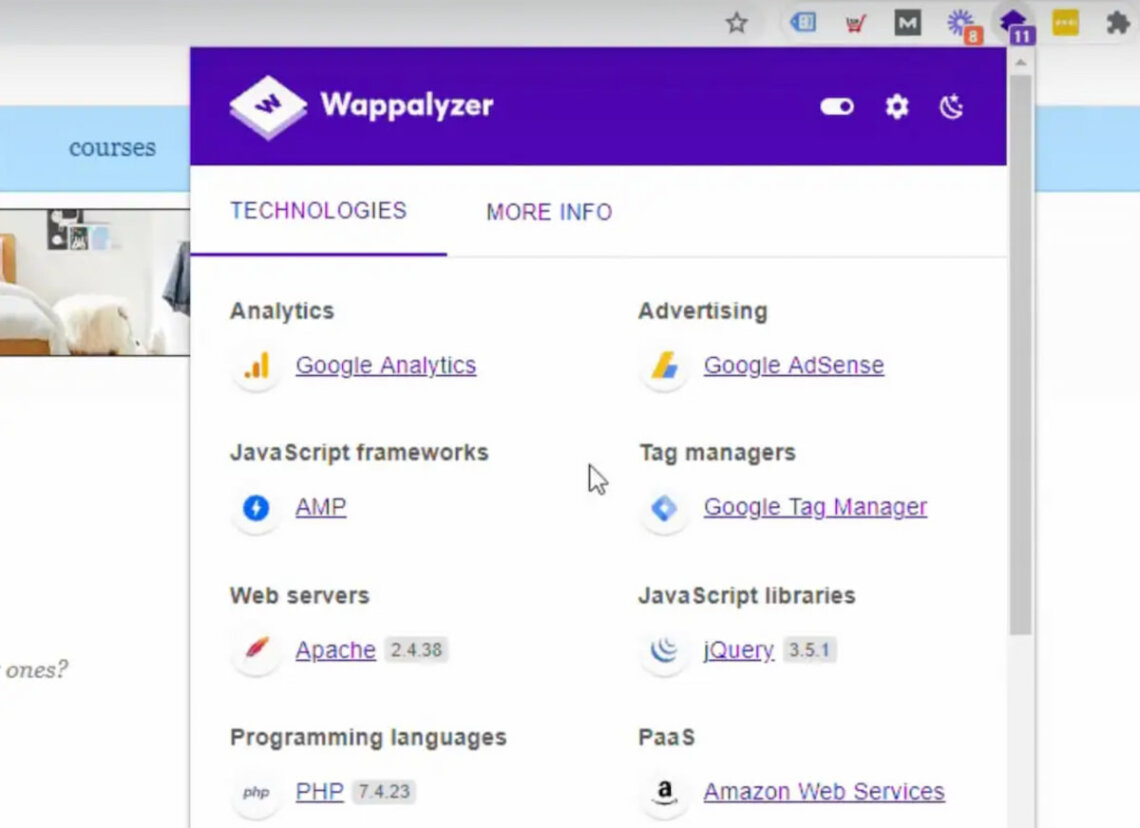
04 Analyze competitors’ SEO efforts
Search Engine Optimization (SEO) is one of the most powerful elements of business and marketing strategy.
Good positioning in search results increases brand visibility, proves your niche expertise, drives organic traffic, and attracts customers. That’s why SEO deserves a special place in our competitor analysis framework.
In fact, an SEO analysis can be divided into at least two subgroups.
Firstly, it focuses on your competitors’ content. In this context, the SEO analysis answers the questions like:
- What’s your competitors’ field of expertise?
- What keywords are they targeting?
- How frequently do they publish content?
- How well is their content performing?
- What content formats do they use?
- What elements do their articles have?
Moreover, you can use content analysis to examine the keyword gap – so, a list of keywords your competitors rank for and you don’t.
You could try to tackle certain keywords and outperform your competitors.
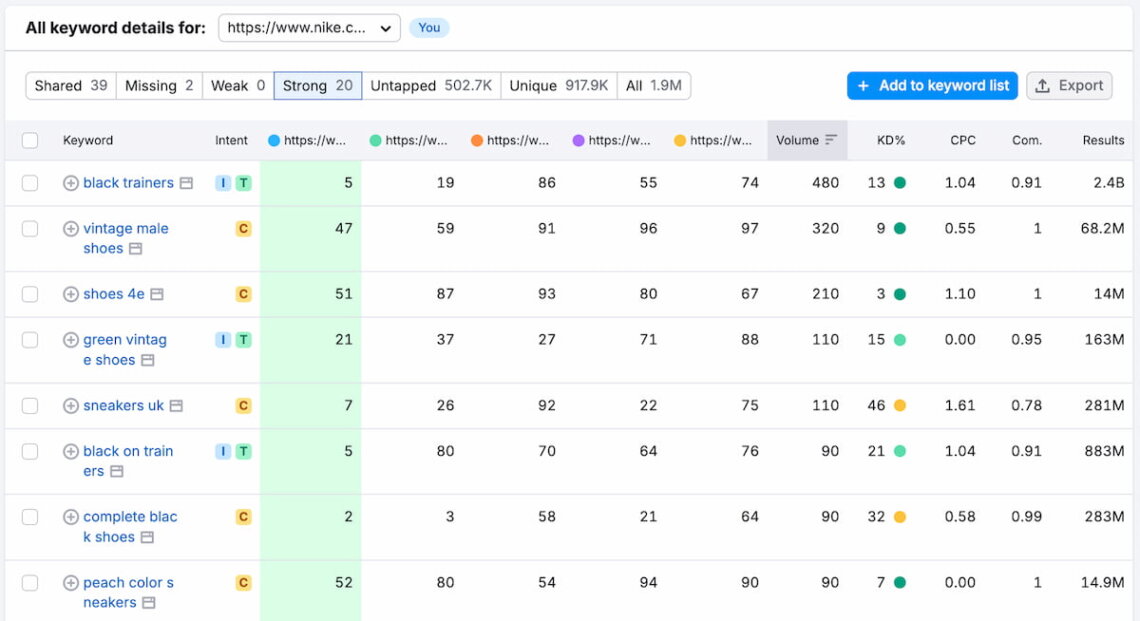
Secondly, SEO analysis covers the technical aspects of the website, which are crucial for determining how well your competitors’ websites are optimized for search engines.
This part looks at elements that impact the site’s performance that you could use to benchmark your website, such as:
- Site speed
- Mobile optimization
- Site structure and navigation (URLs, breadcrumbs)
- On-page SEO elements (titles, meta titles, headers, etc.)
- Backlink profile
Let’s stop for a while.
Backlinks are one of the most important search engine ranking factors. They’re easy to discover and can give you a lot of ideas to build your competitive advantage.
By discovering which domains are linking to your competitor’s content, you get three types of information:
- A checklist of sites that you can ask to replace links to your competitors with content linking to your site;
- A general idea of what type of content is suitable for link building (listicles, data-driven studies, etc.);
- An indicator of what you have to do to beat your competitors.
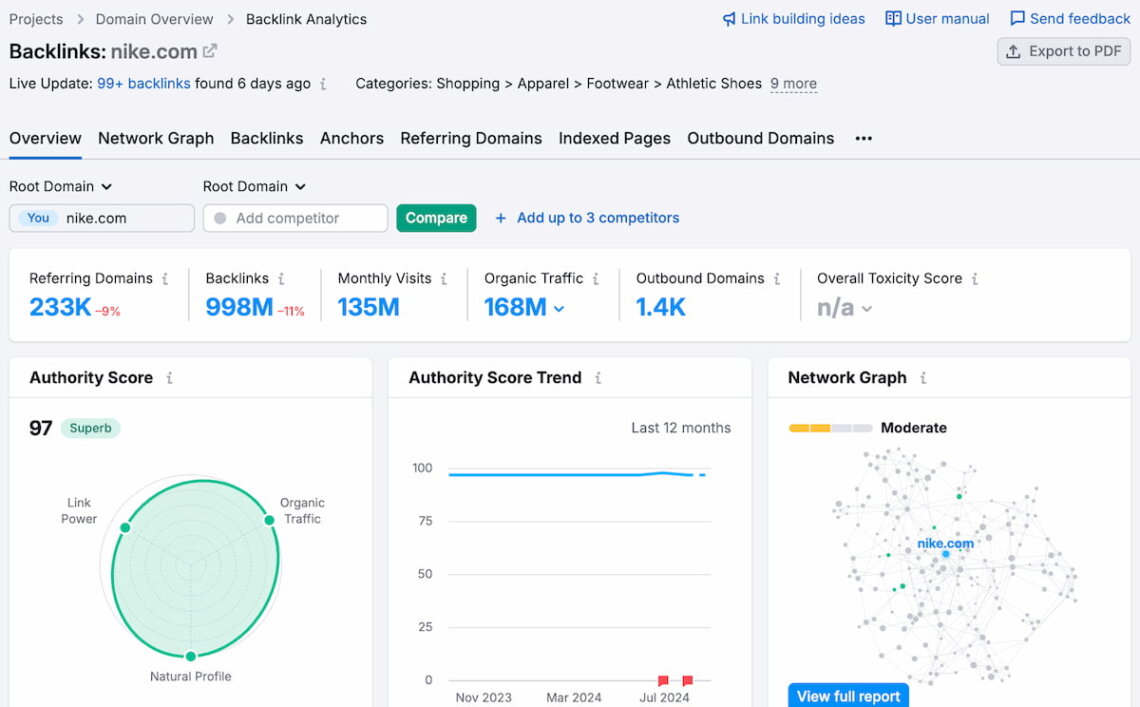
Of course, the details of your content strategy will depend on your industry. However, these three points are universal and will help you assess and direct your content strategy.
How to do competitor analysis?
“Competitor analysis starts by identifying your direct and indirect competitors, typically those who rank for your core keywords, run similar campaigns, or target the same audience. Break the analysis into four key areas: SEO performance (keyword rankings, backlink profiles), content strategy (blog topics, publishing cadence), social media presence (engagement metrics, platform focus), and product positioning (pricing, features, reviews).
Tools like Brand24 help track mentions and sentiment, while Semrush uncovers keyword gaps and traffic sources. The goal is not just to observe but to find strategic openings: where competitors are strong, where they are vulnerable, and where you can differentiate.”
Madhav Mistry, Social Media Specialist
Try Brand24 – it’s simply the best! Better than all the rest!
05 Monitor competitors’ mentions
Monitoring your rivals’ online presence is a part of competitive analysis you simply can’t omit.
Regardless of your business niche, I am more than sure that most of your competitors are active online. They leverage different social media channels or build their growth strategy on media partnerships.
In general, there are two ways to monitor online presence in your competitive landscape:
- Analyze each source separately – by using native analytics tools for social media and Google Alerts for non-social sources
- Analyze all sources from one place – by using software for media monitoring.
Trust me, the first technique is extremely time-consuming and requires spending multiple hours navigating various tools. As such, I definitely recommend you focus on the second method.
Media monitoring tools, like the above-mentioned Brand24, are designed to track and analyze public brand mentions.
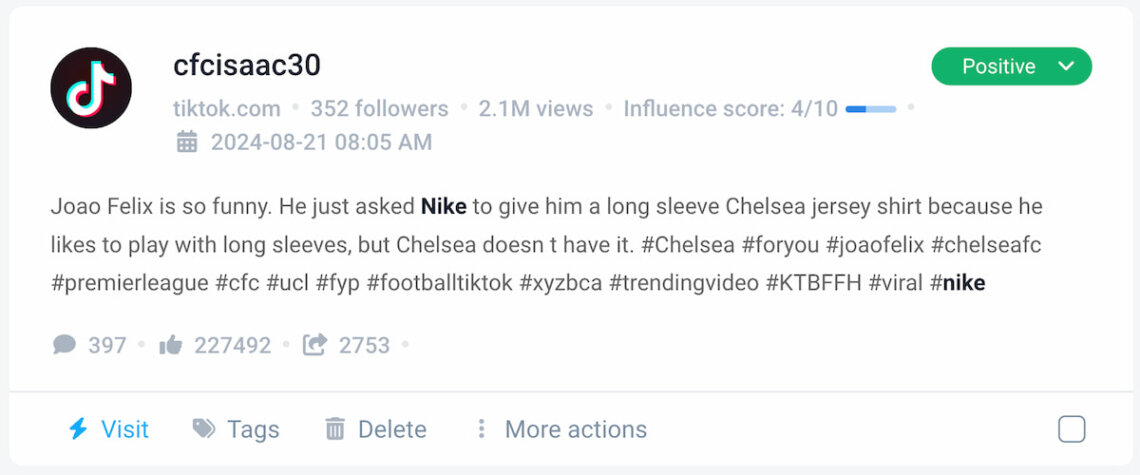
Nowadays, the top tools leverage AI capabilities to make the analysis faster & more accurate and, additionally, have access to nearly all the most important sources of mentions.
For example, Brand24 can track and analyze your brand mentions published on:
- Social media platforms (Facebook, Instagram, X, YouTube, TikTok, LinkedIn, Reddit, Telegram, Twitch)
- News sites, blogs, video sites, podcasts, review platforms, newsletters & other websites
Now, it’s time to show you how to monitor your competitors’ online presence to make your competitive analysis more accurate.
Analyze the volume & reach of your competitor’s mentions
A great starting point is to check how frequently people talk about your competitors.
This knowledge informs you how consistent your competitors are in maintaining their brand awareness efforts and engaging with their target audience.
Tracking your competitors’ mentions allows you to identify seasonal or event-based trends and the impact of their latest marketing campaigns or product launches on their visibility.
Let’s imagine I’m a Nike analyst. I decided to do a competitive analysis using Brand24, and my benchmark is Adidas.
I checked their marketing performance from June to August 2024. There are some huge spikes at the beginning of that period.
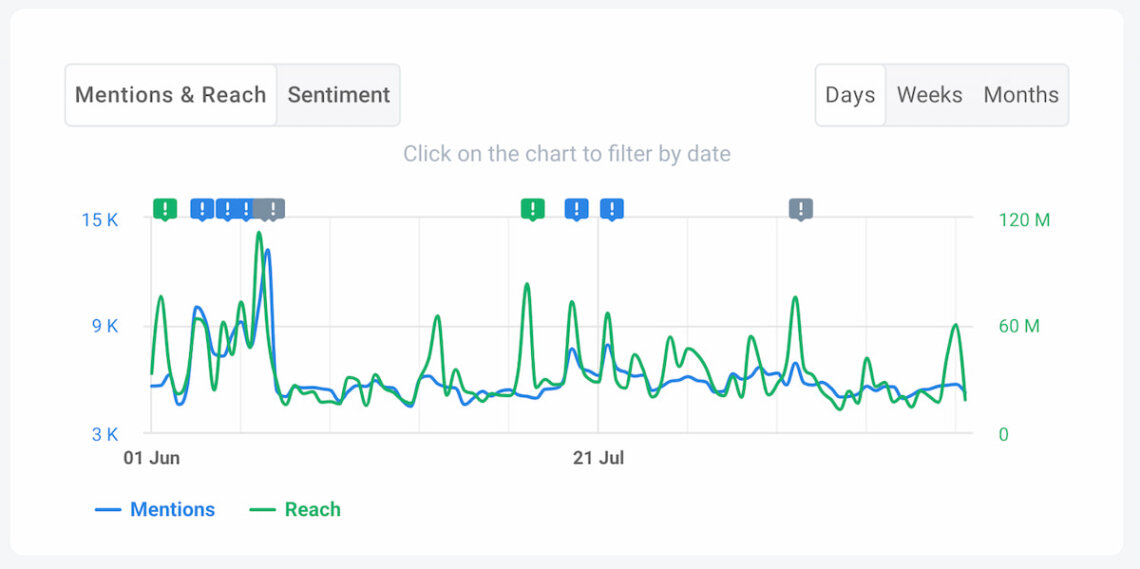
To discover what caused them, I used Brand24’s AI feature called Anomaly Detector.
It automatically discovers unusual patterns in the project (like the huge spike in mentions) and crawls through web and brand mentions to determine the reason behind this anomaly.
The Anomaly Detector told me that the most significant spike from June 13th was caused by the viral TikTok content featuring Adidas promotions of the European Football Championship.
What’s the conclusion of our competitive analysis? Our (Nike’s) most significant rival succeeds with event marketing!
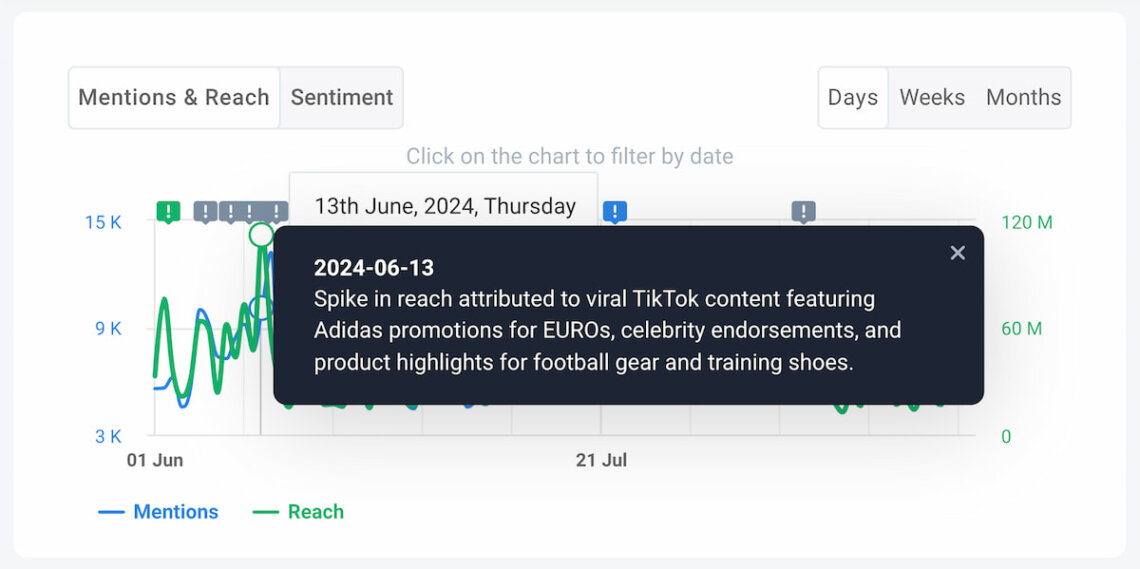
Analyze sentiment
Sentiment analysis is like the flip side of the mentions monitoring coin. It focuses on the quality rather than the quantity of your competitors’ online presence.
Checking it is super easy. Just switch the view to the Sentiment chart.
As you can see below, Adidas’ engagement in the football championship not only increased the brand’s visibility but also generated a positive reception among its target audience.
It confirms our previous conclusion that event marketing works.
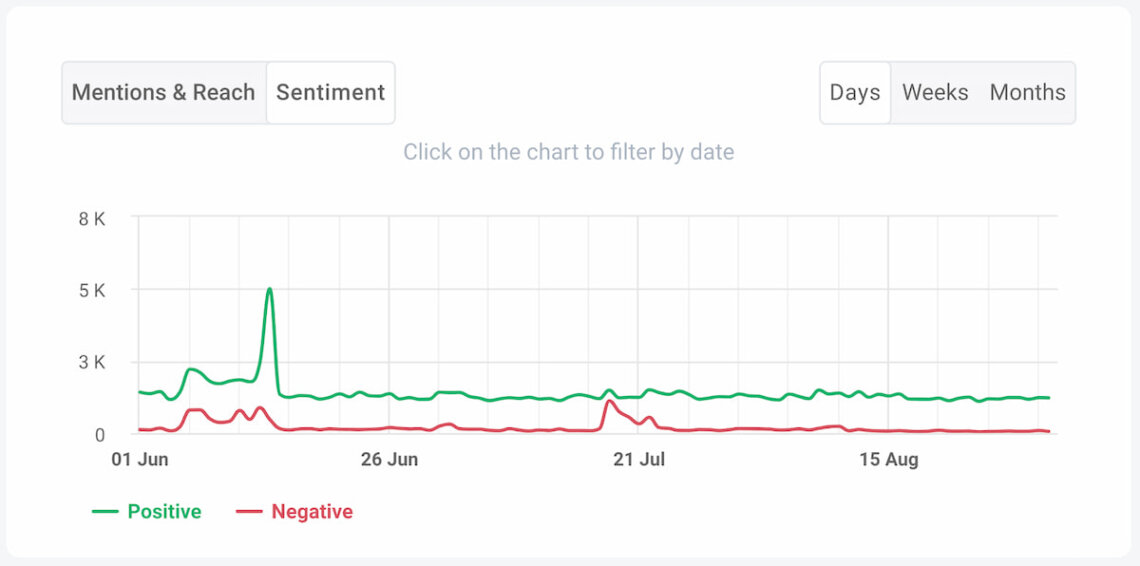
Check top mentions sources
A great follow-up step is to check which sources of mentions play the most important role in your competitors’ online presence.
Such knowledge allows you to see where their audience is most engaged and active, giving you insights into potential areas for your own brand to explore or strengthen.
So, let’s continue our previous competitor analysis for Nike and check Adidas’ top sources of mentions.
To do that, I used another AI-powered Brand24 feature called Metrics Analysis. It automatically presents actionable conclusions based on what’s going on in the tracked project.
As you can see below, Instagram is undisputedly the nu`mber one source of mentions for Adidas. Moreover, there are about 7x more positive mentions than negative ones.
The conclusion?
When it comes to Nike’s social media strategy, the brand should definitely pivot to Instagram.
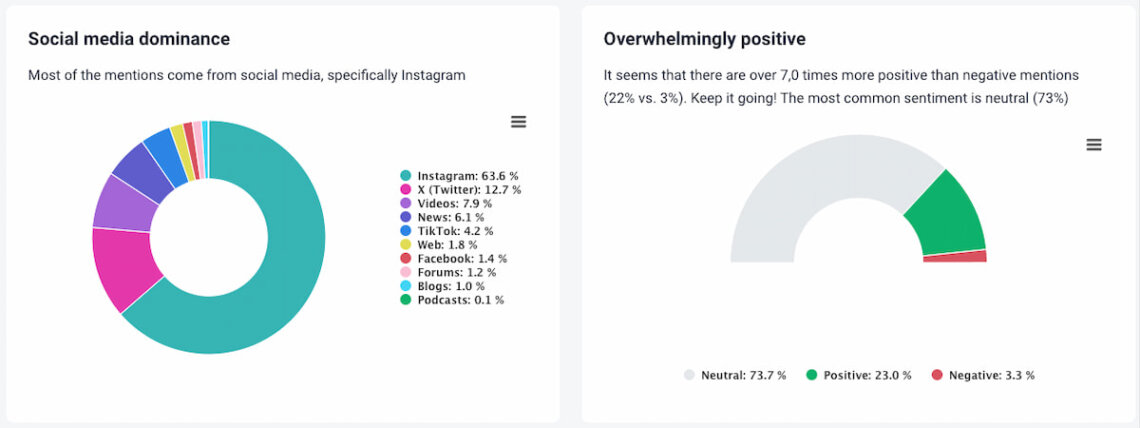
Monitoring your competitor’s performance with Brand24 can unveil much more about your rivals’ strategies. I will not discuss them in detail as we must move forward.
Remember, though, that besides what we discussed above, Brand24 allows you to discover:
- With which influencers do your competitors cooperate;
- What topics generate the most interest and mentions;
- In which days and hours you should post your social media content;
- What hashtags do they use and what’s their hashtag performance;
- In which countries do their target customers live.
Check your competitors’ details!
06 Analyze lead magnets
The next step in our competitor analysis framework is examining your competitors’ lead magnets.
A lead magnet is a free resource or incentive that brands offer to potential customers in exchange for their contact details, preferably an email address.
The goal is to attract leads (a potential customer) that you can target for future marketing efforts.
Some examples of lead magnets:
- Ebooks
- Industry studies and reports
- Free webinars
- Free trials
- Free courses
By analyzing what lead magnets your competitors use, you can discover which marketing tactics work in your niche, identify gaps in your own offerings, and find opportunities to create better resources than your market rivals.
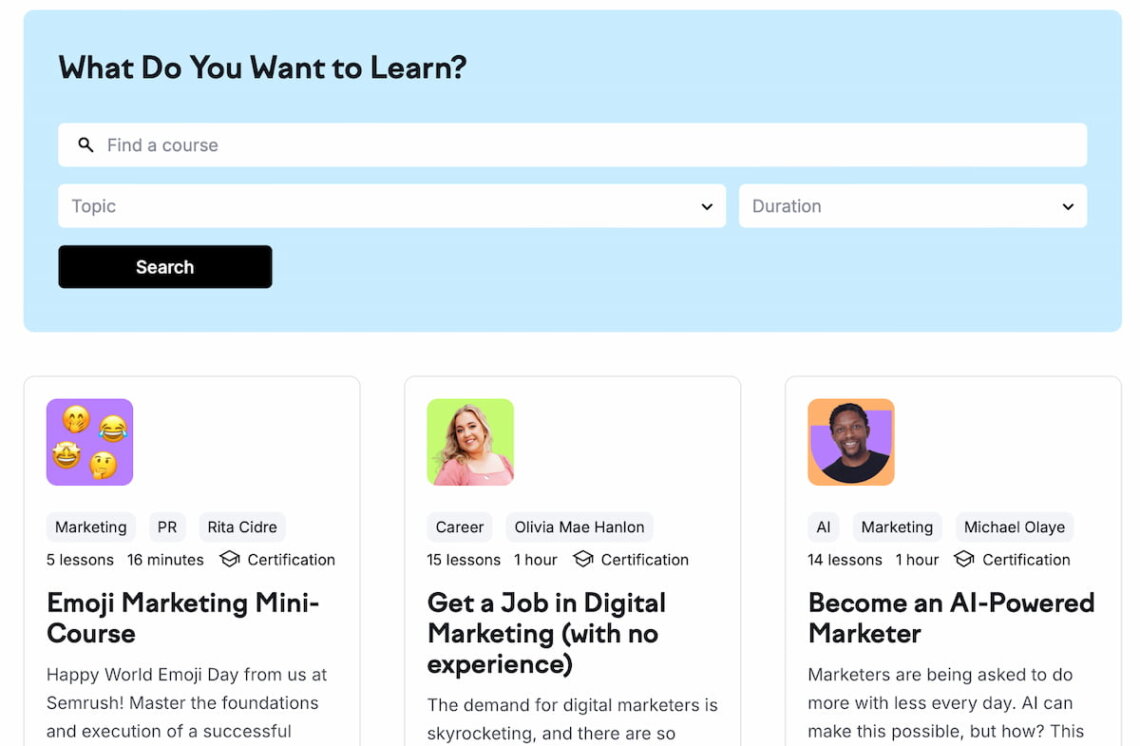
There are several methods you can use to discover your competitor’s lead magnets:
- Review their websites – pay attention to specific sections and elements like resources, pop-ups, free tools, call-to-actions, and assets;
- Subscribe to their email list – this way, you can see your competitor’s strategies from the perspective of its target customer;
- Follow their social media profiles – similarly to subscribing to your rivals’ email list, following their social media gives you a customer perspective;
- Sign up and download their lead magnets – go through the process yourself to experience the entire lead journey, from signing up to receiving follow-up email communication.
07 Take a look at the pricing strategy
Another incredibly important aspect of your competitor analysis is discovering your rivals’ pricing.
Analyzing the pricing can be daunting, as there are many variables involved.
The offerings might differ slightly, depending on the features offered by each company. Find as much common ground as you can and compare the plans.
This will show you whether you’re charging an adequate amount of money for your product.
Maybe there are some features you could add to your offering to make it more attractive.
Or, on the contrary, you might have a competitive advantage over your rivals you’re not aware of. That’s a perfect way to promote your business!
If your competitor does not disclaim its pricing, search for it on Facebook groups or platforms like Reddit or Quora. You can also overview relevant review platforms.
08 Compare the customer experience
According to a G2 study, 91% of customers are more likely to make another purchase after a great customer service experience (CX).
That’s only one of many stats underlining the importance of customer service. And that’s why you should carefully look at your competitors performance in this area.
In practice, you can use the following tactics:
- Examine customer support channels – try the live chat, email, social media & other support channels by yourself and study your competitors’ personalization, response time & quality;
- Monitor customer reviews and feedback – depending on your industry, implement review monitoring on niche-relevant platforms.
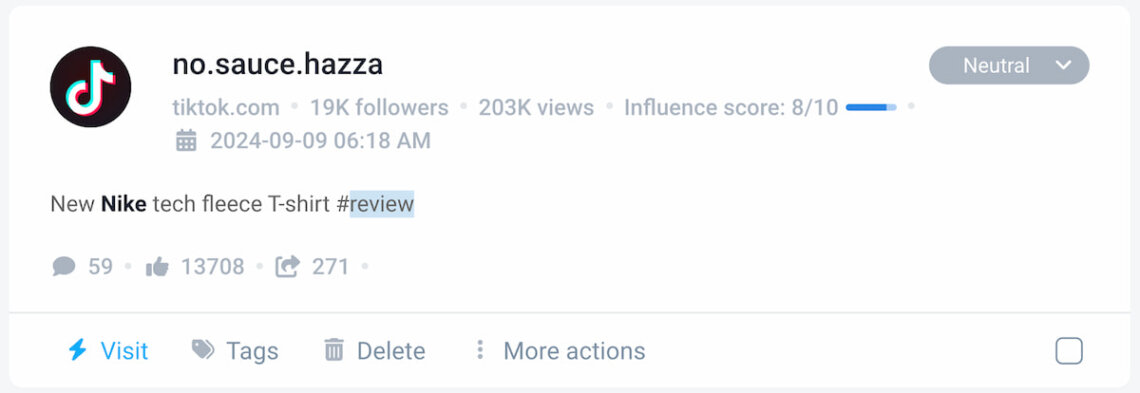
Competitor comparison
Now, you have a comprehensive understanding of your competitors’ strengths and weaknesses.
In the end, I want to show you one extra powerful technique for competitive analysis: a competitor comparison.
As the name suggests, competitor comparison means evaluating your business against competitors by comparing chosen factors.
It’s quite a complex process that could involve basically everything we discussed in this article. To show you the mechanism, let’s narrow it down to brand reputation and visibility issues only.
When you visit Brand24, you can open a Comparison tab. Choosing the “Compare projects” function enables you to benchmark different projects.
That’s how you can see your brand performance compared to the chosen competitors.
Namely, you can compare things like:
- Volume and reach of your brand mentions;
- Volume and share of your positive & negative sentiment;
- Presence Score
- Advertisement Value Equivalency (AVE)
- User-generated content
- Share of Voice
I will show you this in practice. Let’s continue our sample competitor analysis from the perspective of Nike and benchmark it with Adidas.
As you can see below, Nike is generally a more visible brand.
What surprised me is that, despite Nike has twice as much social media mentions as Adidas, their social reach is nearly the same. It means that an average Adidas mention has a more significant reach than average Nike mentions.
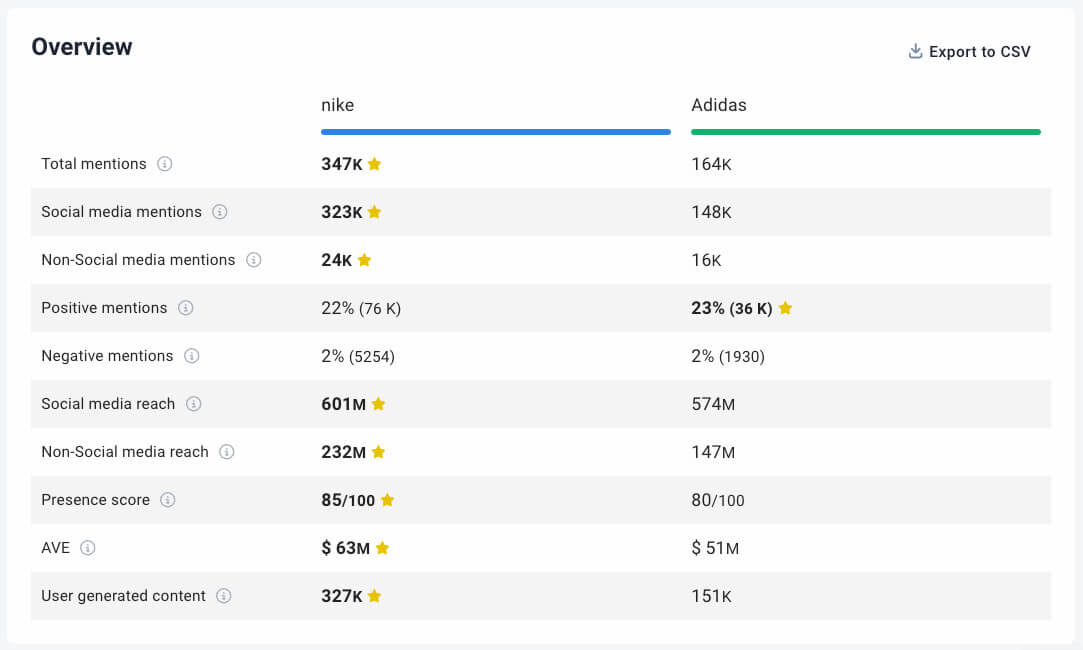
I asked the AI Brand Assistant about what caused that.
It turned out that Adidas was mentioned by some highly influential social media profiles, such as Real Madrid or Kanye West.
Besides, according to the Brand Assistant analysis, Adidas is more successful in influencer partnerships. Interesting!
Compare your performance with your competitors!
Conclusion
An AI-driven competitor analysis isn’t just a nice-to-have for brands that are hungry for success. It’s a must.
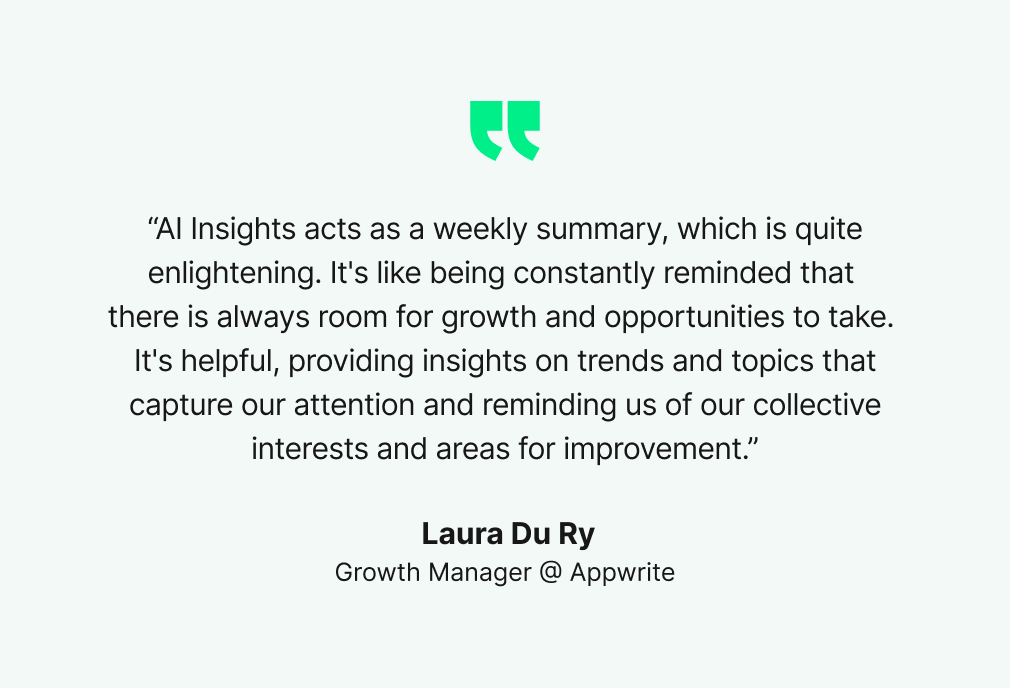
Discover our client’s success story — read the case study.
By taking a closer look at your rivals’ strategies, from their marketing tactics to customer engagement, can uncover valuable insights to strengthen your own approach.
Precisely speaking, understanding what your competitors do well and where they fall short allows you to identify gaps, refine your strategy, and position your brand more effectively.
Remember, though, that this analysis isn’t just about tracking data – it’s about turning that data into actionable steps that give you a competitive edge.
So, don’t leave your strategy to guesswork! Utilize all the insights to make more informed decisions, optimize your efforts, and elevate your brand in the market. Good luck!
Curious about real-world case studies? Dive deeper into how global giants like Amazon, Boeing, Uber, and Airbnb battle for market dominance.
Final thoughts:
- Competitor analysis is not a one-time task. You should perform it regularly to stay agile and adjust your strategy to market changes.
- Understanding your competitors’ strengths and weaknesses unveils gaps you can fill to gain a competitive edge.
- You don’t have to spend thousands of dollars for a professional competitor analysis. Great competitor analysis tools are at your fingertips.
- Work smart, not hard – use AI tools like Brand24 to automate competitor analysis.
Now, you’re 99% ready for your competitor analysis!
If you want to be 100% prepared, sign up for a free 14-day trial of Brand24 and unlock the full potential of your competitive insights.




